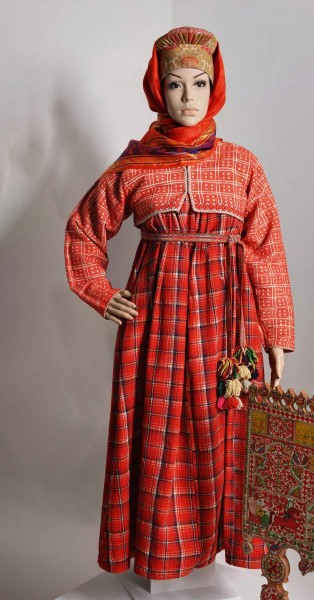Peasant Woman’s Costume
Pinega District, Arkhangelsk Gubernia. Late 19th — early 20th century
Sarafan — Pestryadinnik
Flax, weaving
Kabatukha
Wool, weaving
Sash
Wool, weaving
No sash is the same as no cross…
The girdle, sash or belt has been an ever-present part of male, female and children’s clothing, whatever the person’s status, since ancient times, as witnessed by proverbs, sayings and archaeological finds. The sash was not only for tying clothes; it also protected the wearer from the dangerous forces of the outside world. Sashes differ in color, size, material and how they are worn. Depending on how they are made they are divided into woven, knitted and spliced. They are different in width, complexity of design and finish. Spliced sashes and strings were knitted on needles or forks. Woven sashes were made on complex looms and simpler ones on simple weaving boards. Wide belts were also made from manufactured cloth. In the Russian North sashes were usually bright with complex textured patterns, a wonderful accessory to the dress. The sash was not tied over brocade or silk sarafans but was worn underneath to avoid damage to the expensive cloth. In many Russian regions sashes with the words of prayers and psalms, good luck wishes or personal woes were common. It is possible to read the name of their owner or the craftswoman on them, often with the exact description of the place they were manufactured.
Headscarf
Silk, weaving
Kokoshnik (Morkhatka)
Brocade, canvas
Checked homemade cloth, coarse motley, was common in the Russian North. A coarse cloth sarafan (pestryadinnik) made from bright checked cloth could be worn on a usual day or a feast day, depending on the complexity of the checks and the density of the cloth used. On top of the sarafan and shirt a kabatukha or kabatushka — a short cardigan with long straight sleeves — was worn. This amazing item of clothing is not found anywhere else. It somewhat resembles the short spencers which were popular in the early 19th century, sometimes referred to as “shpenzels” in northern villages.

